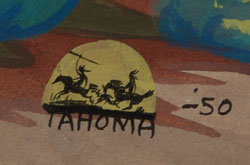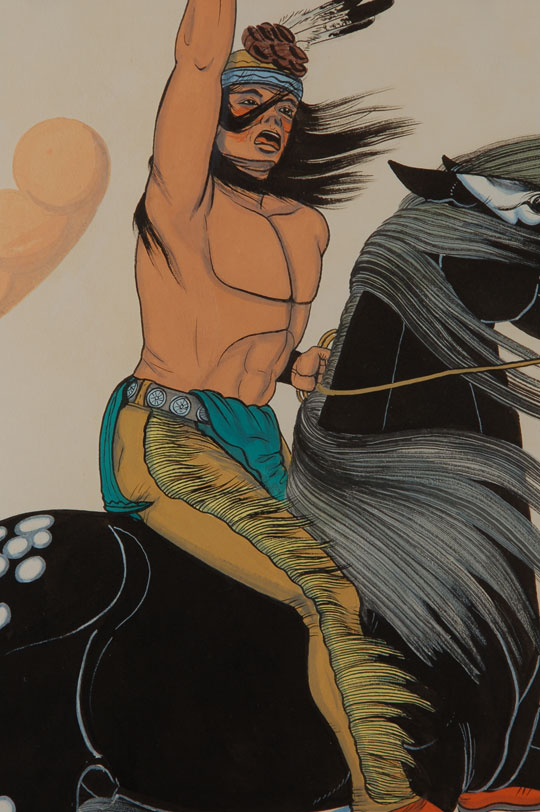Original Painting Entitled “The Scout” [SOLD]
+ Add to my watchlist Forward to Friend
- Category: Paintings
- Origin: Diné of the Navajo Nation
- Medium: Gouache
- Size: 21” x 13-1/8” image; 28-1/8” x 19-1/8” framed
- Item # C3198D SOLD

"One of the most dynamic, imaginative, and gifted of Southwest Indian Artists."-Clara Lee Tanner, 1973.
Tahoma attended the Santa Fe Indian School for four years, from 1936-1940, entering in the seventh grade. He was a student at the same time as Harrison Begay, Pablita Velarde, Geronima Montoya, Andy Tsihnahjinnie, and Gerald Nailor, and studied under the tutelage of Dorothy Dunn at The Studio.
When World War II broke out, he attempted to join the military service to serve with his many Native American friends who had joined, but a childhood accident which left his left arm deformed prevented his acceptance. He spent the war years in Santa Fe.
Tahoma displayed a wide variety of styles in his paintings. He had a "quiet" period, a "peaceful" period and a "violent period." His quiet and peaceful periods were early and late in his career, with his violent period predominating for most of his art life.
Tahoma painted the proud Diné in everyday life on the reservation where he had grown up to the time of leaving for the Santa Fe Indian School at about age 12 or 13. This painting of a Diné man on horseback with a spear raised above his head was entitled "The Scout" by Tahoma and it originally was priced at $25.
The previous owner of this painting was riding with Tahoma from Santa Fe to Taos to sell two paintings that he had just completed when one of them spilled a drink on this one. They continued on to Taos, sold the other painting, and this owner retained this one in her collection until just recently.
We had the painting professionally attended to by a paper conservator who removed the stain to the point that it is no longer visible. We have her certificate of conservation which will accompany the painting.
This style of Tahoma's paintings is strong and powerful but not violent. The warrior is rendered with a muscular body and the horse is active, but neither figure appears angry or stressful. It is a style that Tahoma mastered and it is one most collectors relish.
Condition: Now that a professional paper conservator has treated the paper, it is in acid-free state and it has been framed using all acid-free materials and museum glass. The original illustration board backing the painting has been retained because it has Tahoma's handwritten notation "The Scout" By Tahoma of Santa Fe Price $25.00 and it features a pencil sketch of a bow and arrow.
Provenance: ex.coll. Santa Clara Pueblo artist, the original owner.
Recommended Reading: Quincy Tahoma: The Life and Legacy of a Navajo Artist

- Category: Paintings
- Origin: Diné of the Navajo Nation
- Medium: Gouache
- Size: 21” x 13-1/8” image; 28-1/8” x 19-1/8” framed
- Item # C3198D SOLD



